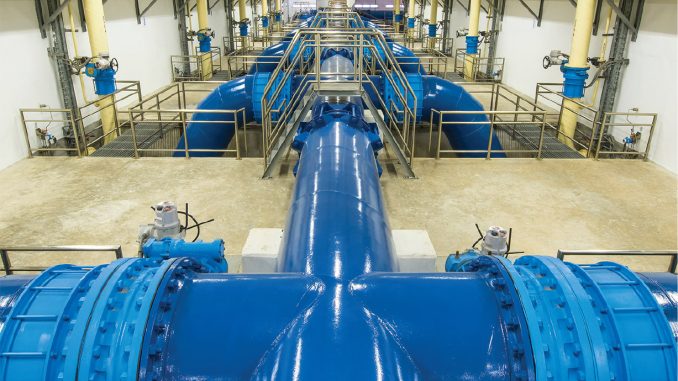
Pumped storage plants (PSPs) play an important role in providing peaking power and maintaining system stability in the power system. At present, it is the only viable technology for large-scale energy storage. PSPs allow the storage of excess energy from solar, wind or baseload sources (such as coal and nuclear) for periods of high demand. Besides being green in nature, PSPs offer several advantages as they allow time shifting and reduce renewable curtailment, resulting in availability of round-the-clock renewable energy. They also help in peak shaving and frequency regulation, provide ramping capability, black start, spinning reserve, reactive power and voltage control, and inertia support. Thus, PSPs would play a key role in maintaining grid stability in the emerging power sector scenario.
Pumped storage technology has advanced significantly since its original introduction and now includes adjustable speed pumped turbines, which can quickly shift from motor to generator, to synchronous condenser modes, for easier and more flexible grid operation. A relatively new approach for developing pumped storage projects is to locate reservoirs in areas that are physically separated from the existing river systems. These projects are closed-loop pumped storage because they have minimal to no impact on the existing river systems. The concept of off-river PSPs is getting popular in recent years due to huge benefits arising out of its fewer capital cost/operations. Currently, India is exploring off-river storage systems, which can be implemented at a lower cost and a faster pace.
Benefits and growth drivers of PSP
Pumped storage technology is a technically proven, cost-effective, highly efficient, environment-friendly and flexible way to store energy on a large scale from intermittent and variable solar and wind energy sources. PSPs provide spinning reserve at almost no cost to the system and regulate frequency to meet sudden load changes in the network. It also has the ability to provide ancillary benefits such as flexible capacity, voltage support, black-start facility, etc. The high flexibility of PSPs and their ability to rapidly switch between pumping and generation allows their to provide up to twice their capacity to meet system ramping needs. Apart from this, the operational flexibility of PSPs can influence power flows in the transmission network. Depending on its location, a PSP may, therefore, reduce transmission congestion, improve the utilisation of transmission assets and reduce the need for new transmission capacity.
Status of PSP development
As per the Central Electricity Authority (CEA), India has eight pumped storage projects, with a total capacity of 4,745.6 MW as of November 2022, installed in various locations across the country including Telangana (2), Maharashtra (2), Tamil Nadu (1), West Bengal (1) and Gujarat (2). However, only six plants with an installed capacity of 3,305.6 MW are working in the pumped mode. The remaining 1,440 MW of capacity across two sites in Gujarat is currently not operating in the pumped mode due to delay in construction of the tail reservoir and vibration-related issues in the system.
Three PSP projects are under construction with a total capacity of 2,700 MW. The 1,000 MW (4×250 MW) Tehri Stage II project in Uttarakhand being implemented by THDC Limited is likely to be commissioned by 2023-24. It will be the first PSP in the central sector. The 500 MW (4×125 MW) Kundah PSP Stages I, II, III and IV, being implemented by the Tamil Nadu Generation and Distribution Corporation Limited in Tamil Nadu, is likely to be commissioned by 2024-25. The 1,200 MW (4×240 + 2×120 MW) Pinnapuram project being implemented by Greenko in Andhra Pradesh is likely to be commissioned by 2024-25. It is the first of its kind integrated renewable energy project in India, conceived as a GW integrated project with solar, wind and pumped storage components. The project features an offstream closed loop standalone storage system and will have a cycle efficiency of 75 per cent. Meanwhile, construction of the Koyna Left Bank (80 MW) power project in Maharashtra, being implemented by the Water Resources Department of the state, is held up. The detailed project report (DPR) for the Turga project (4×250 MW) in West Bengal has been concurred by the CEA. Currently, survey and investigation (S&I) is in progress for 18 projects totalling 21,960 MW. Further, S&I of five projects totalling 3,670 MW is held up.
Various private sector players have announced PSP projects in recent times. In October 2022, JSW Energy Limited signed an agreement with the Maharashtra government to set up a 960 MW PSP project in Raigarh district. In April 2022, JSW expressed interest to develop the 1,000 MW Hasdev Bango PSP in Chhattisgarh and the 1,500 MW Komoram Bheem PSP in Telangana. More recently, in January 2023, the Greenko Group announced setting up of a PSP project in Neemuch, Madhya Pradesh. In the same month, Adani announced a plan to set up a PSP in Madhya Pradesh. Further, in December 2022, Adani Green Energy Limited received the go-ahead to set up 1,600 MW of PSP projects in Andhra Pradesh.
Policy interventions
In the recently notified Electricity (Amendment) Rules, 2022, the government has reduced the timeline for granting concurrence to hydropower plants and off-the-river PSPs to 150 days and 90 days respectively.
To promote commissioning and optimum utilisation of storage projects, the central government, in 2021, issued waiver of interstate transmission system (ISTS) charges for transmission of electricity supplied by hydro PSP and battery energy storage system (BESS) projects commissioned till June 30, 2025. For this, at least 70 per cent of the annual electricity generation requirement for pumping water at a PSP plant has to be met by the use of solar- and wind-based generation. The ISTS charges for power supplied from hydro PSP or BESS projects will be levied gradually – 25 per cent of short-term open access (STOA) charges for the initial five years of operation; after five years, charges will be increased in steps of 25 per cent every third year to reach 100 per cent of STOA charges from the 12th year onwards. These will also be aligned with the gradual reduction in tariff and payment of debt. The order also mandates the waiver of transmission charges for trading of electricity generated/supplied from solar, wind, PSP and BESS in the green term-ahead market and the green day-ahead market till June 30, 2023.
Earlier, in March 2019, the government had issued an order detailing various policy measures to promote the hydropower sector in India inter-alia, declaring large hydropower projects including pumped storage projects with a capacity of more than 25 MW that come into commercial operation after March 8, 2019, as a renewable energy source. It also specified a hydropower purchase obligation within the non-solar renewable purchase obligation. Further, in 2021, the Ministry of Power issued detailed guidelines for the release of budgetary support towards the cost of enabling infrastructure, that is, roads/bridges and flood moderation component of hydroelectric projects, including PSPs.

 Challenges
Challenges
The CEA has estimated the overall potential of PSPs in the country at 96,529.6 MW. Yet, only 4.92 per cent is currently operational in India, depicting the slow growth of PSPs in the country. With regard to PSP deployment, there are issues related to suitable site selection, finalisation of the project layout, operating limitations during monsoon, machine selection and equipment supply timelines. Monopoly in the supply of equipment and limited financing options also hinder the adoption of PSPs.
Onstream PSPs require construction of large dams and reservoirs, thus, may impact the natural water system. Further, environment and rehabilitation and resettlement in the case of large dams and reservoirs often adversely affect timely completion of projects. Long planning lead times and high construction costs are major issues hindering the growth of the segment. The ancillary services provided by PSPs are limited only to spinning reserves and there is a lack of differential tariff for PSP for peaking generation. In the case of off-river PSPs, there are issues with respect to availability of water for initial filling of reservoirs.
To foster greater uptake, the functions and benefits of PSPs need to be highlighted. Further, there is an urgent need for a pricing mechanism that can ensure profit generation for developers over and above their fixed cost and variable cost components.
Future prospects
As per the CEA’s latest Draft National Electricity Plan (Generation), a PSP-based storage capacity of about 6.81 GW with 46.65 GWh of storage is required by the year 2026-27 to fulfil the storage requirement of the grid. The storage capacity requirement will increase to 70.38 GW (18.82 GW PSP and 51.56 GW BESS) with storage of 392.78 GWh (135 GWh from PSPs and 257.78 GWh from BESSs) by the year 2031-32.
According to sector experts, the government is also working on formulating a draft PSP Policy, which will set out the long-term plan for pumped storage hydro development and indicate PSP projects to hydro central public sector enterprises. It is also expected to overcome challenges facing the segment and make provisions for relaxed environment and forest norms for PSPs including off-the river PSPs; priority to offstream PSPs; waiver of free power; development of the hydropower market; monetisation of intangible benefits; green finance for reducing storage cost; funding of transmission systems from the PSPs to the nearest transmission pooling point; and priority financing to PSPs, among others.
Going forward, with greater influx of variable and intermittent renewable energy, PSPs can play a key role in providing balancing power. In view of the large renewable energy capacity addition planned for the next few years, PSPs are expected to play a vital role in providing clean and balancing power, and addressing intermittency issues associated with renewable energy sources. Therefore, it is pertinent to ensure the timely completion of ongoing PSPs, develop new capacity in a time-bound manner, and address policy and regulatory issues to facilitate the development of PSPs.



